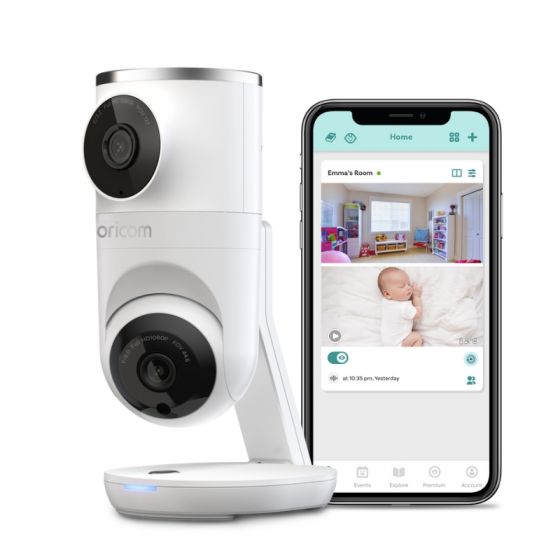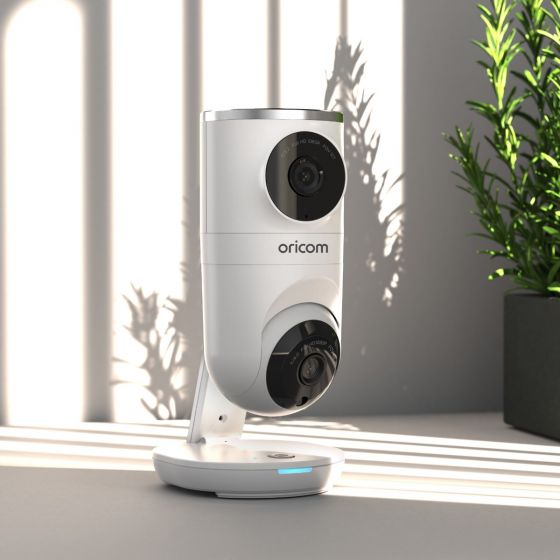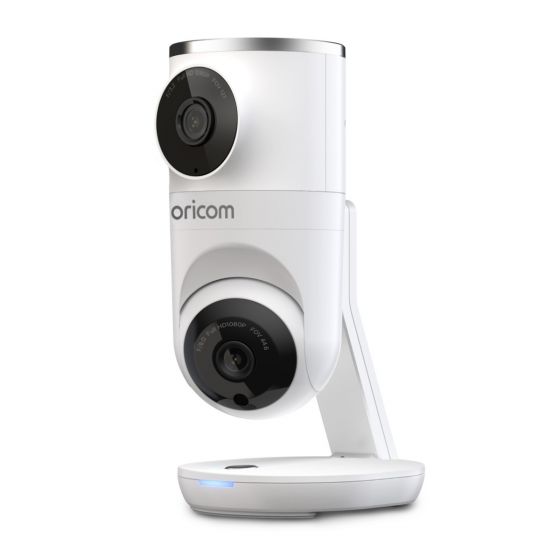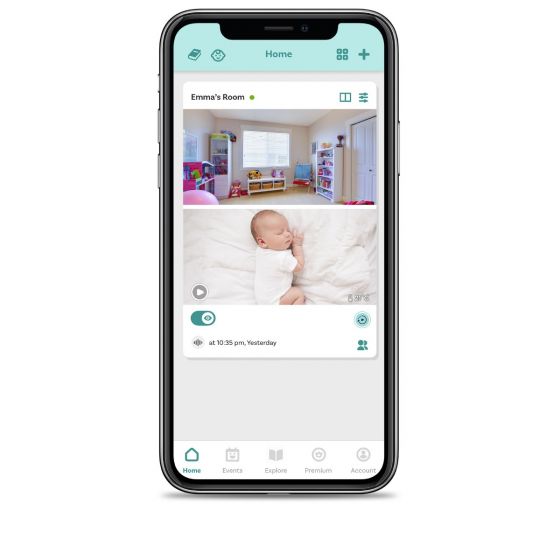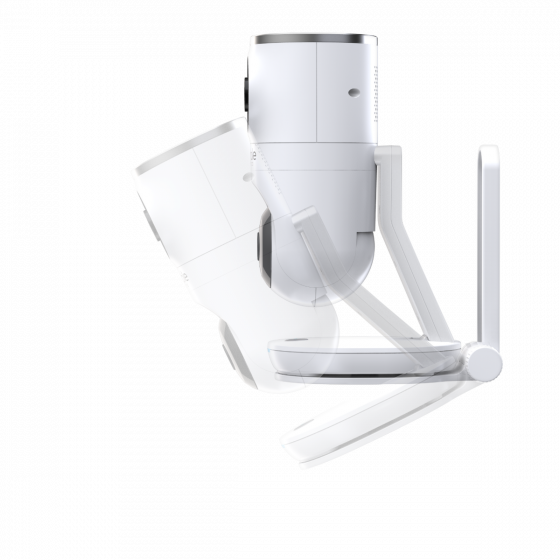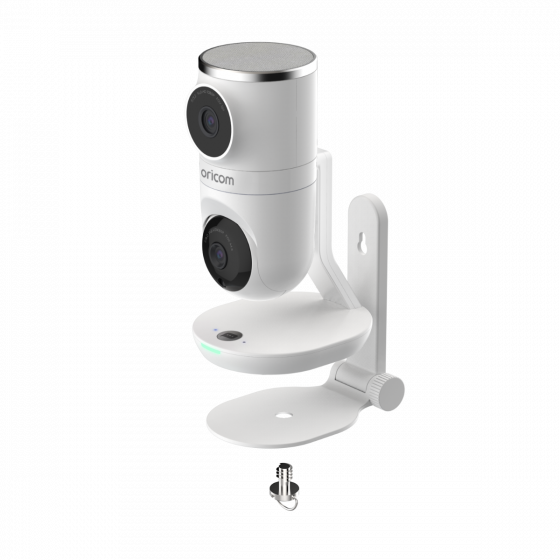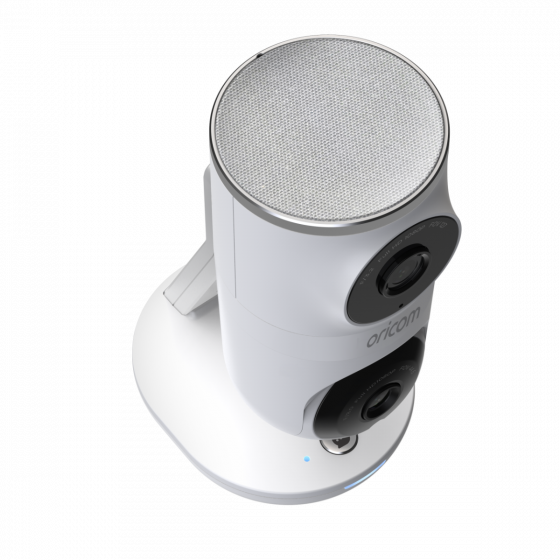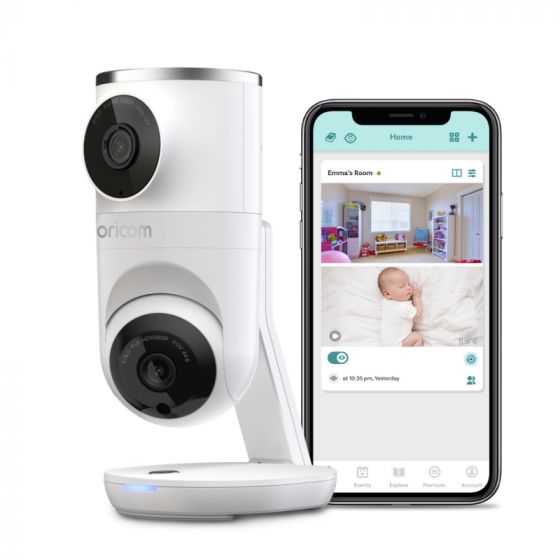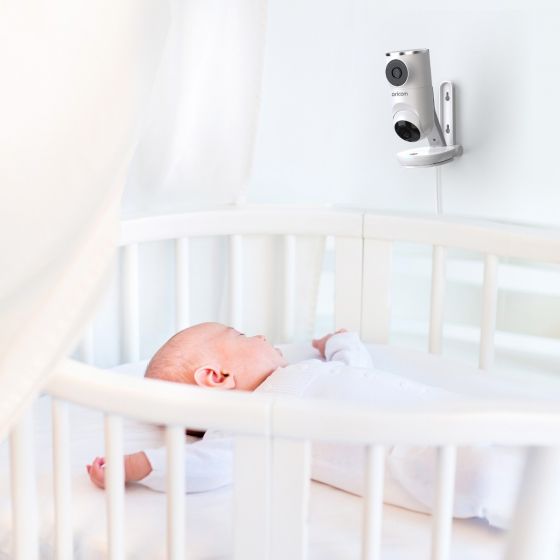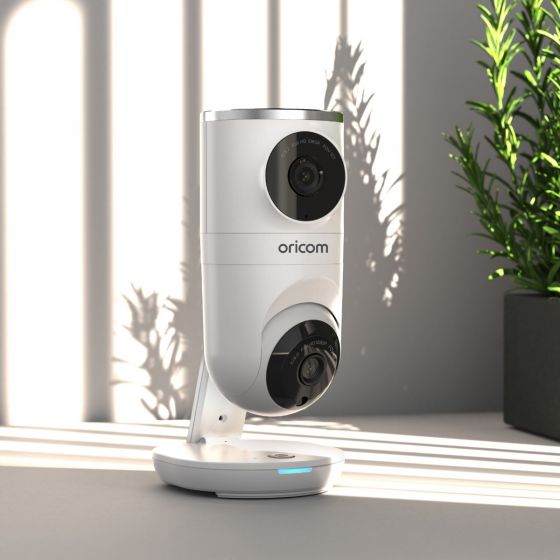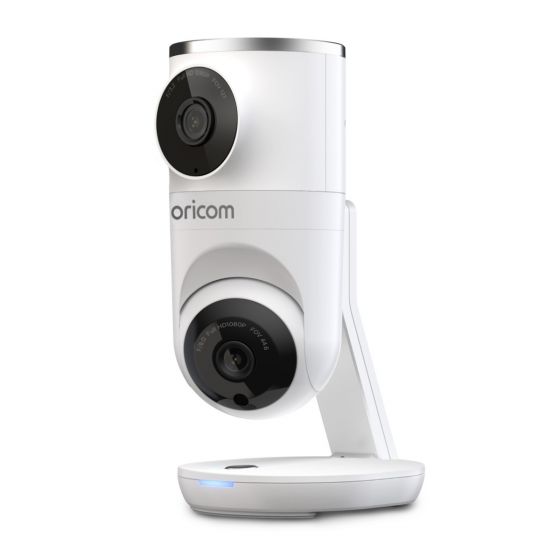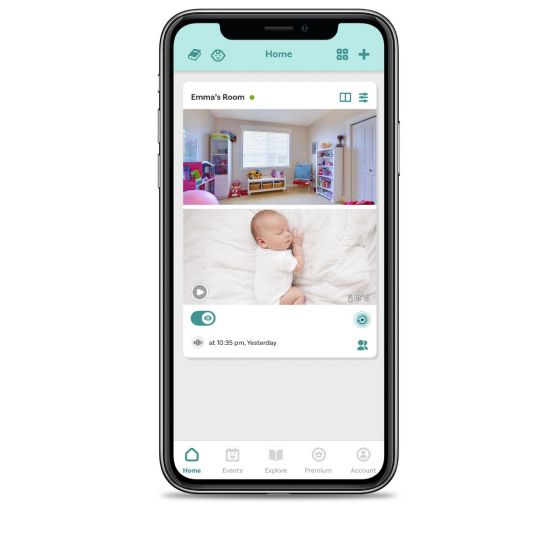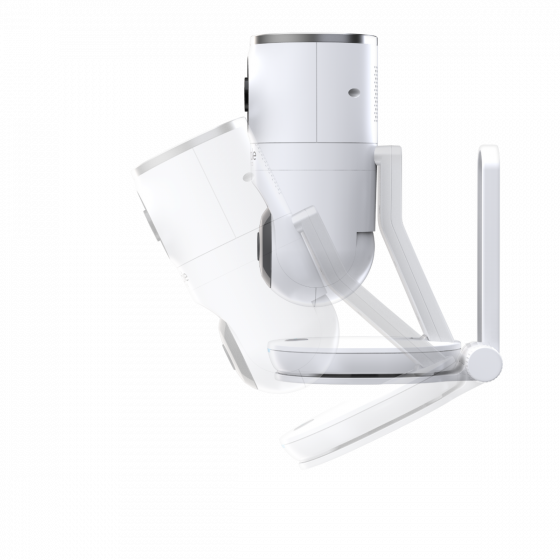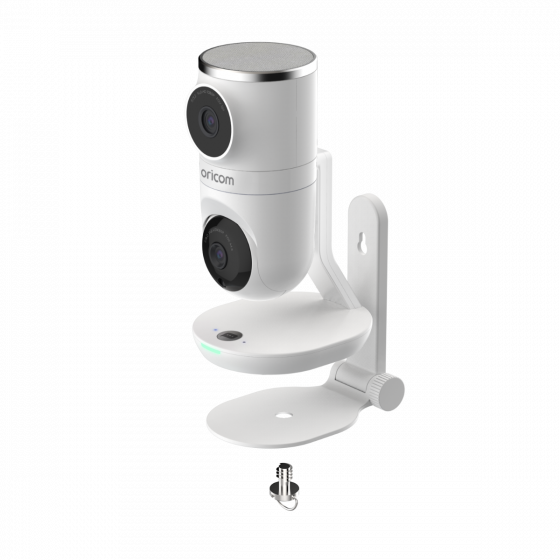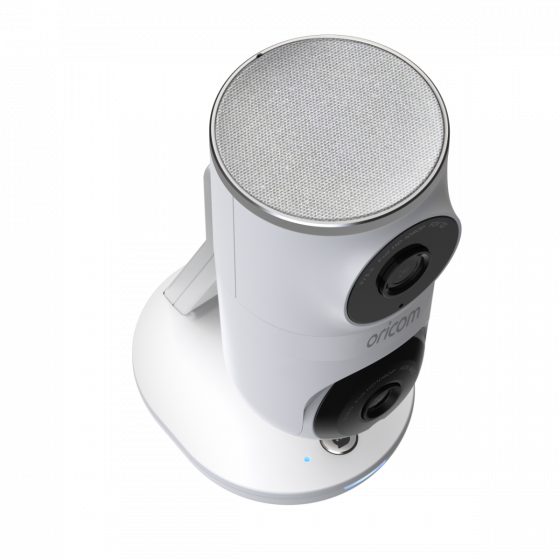Smart HD Dual Camera Baby Monitor
Smart HD Dual Camera Baby Monitor
SKU:OBHDUAL
In stock
Couldn't load pickup availability
Overview
Overview
Introducing the Oricom HD Dual Vision camera, the smart baby monitor which features dual lenses for standard and wide-angle viewing, from the same device. Simply pair the camera to the FREE HubbleClub for Partners app (available on the Apple App store and Google Play store), and you can view both feeds simultaneously on your smart device.
Baby monitors are no longer just for parents – Lull your little one to sleep with pre-loaded nature sounds, lullabies & audiobooks, soothe them with your familiar voice using Two-Way Talk, and even track nursery room temperatures with the touch of a button to ensure your newborn is always comfortable.
An innovative baby monitor that brings you much more than just a way to watch over your children. Including dual lenses for standard and wide angle viewing angles, this baby monitor will ensure you capture even more of the nursery, and is the innovation Australian parents have been asking for.
The Oricom HD Dual Camera shoots in 1080p HD and with pristine infrared night vision, this baby monitor provides crystal clear monitoring, even in total darkness. The OBHDUAL is the reliable friend that makes bedtime easier for the whole family, with the camera feed viewable on your Smart Device at home (not included).
Technical Specification
Technical Specification
Delivery and Returns
Delivery and Returns
- Delivery: Free within NZ on orders over $100 (excluding bulky items) or $8 standard shipping
- Returns: Accepted within 14 days of receipt with proof of purchase
- Some items are excluded from returns including sale items, hardware, car seats, prams, monitors and personal items - please click here for the full list.
Share this product
Recently Viewed Products
Related Blogs
What you need to know about baby monitors
Keep your eye on bubs while they're fast asleep Becoming a parent is a rollercoaster of emotions and new experiences. You’ve spent nine months with your baby tucked safely in your belly, and now that they've made it Earth-side, you can’t wait to bring them home. When it comes to sleeping, you may have your mini-me in your room or nursery. At some point they will move into their own bedroom, and it’s quite natural to feel anxious about leaving your tiny human alone. That’s where baby monitors allow you to keep an eye and ear on your little one from anywhere in the house (outside too!). Baby monitors provide peace of mind for parents who worry that they might not wake when baby stirs or cries, signaling it’s time for a feed – or perhaps just stretching. In today’s tech-driven world, baby monitors are almost a given, and these days they come with lots of features. Here’s what you need to know when buying a baby monitor: Types of baby monitors Audio Sound-only monitors are essentially like a walkie-talkie – they’ll let you listen to your baby as they sleep. They focus on minimising background noise so you can hear cries and coos from the crib. Many audio monitors will light-up when your baby stirs, glowing brighter as their cries get louder. Video and audio Watch your baby – as well as hear them! These monitors work through a small camera mounted on the nursery wall or a flat surface beside baby’s crib. Night vision provides a clearer image when the lights are off, and touch-screen features let you zoom in or tilt the camera. Some can feed a live stream to multiple cameras, helping you keep an eye out from any room in the house. Wireless network Most monitors use radio-frequency transmission, but these digital monitors connect to your home Wi-Fi or mobile network. For example, the Owlet Cam lets you stream audio and high-definition video of your baby directly to your smartphone via the Owlet app. Some will send your device notifications when there has been a change in movement or sound. Key baby monitor features Like many technology-based products, baby monitors have advanced in leaps and bounds. Some have amazing add-ons which certainly make life easier, but there are some essential features you should consider: Rechargeable batteries . Pick a model that can recharge or be plugged in instead of relying on batteries.= Low-battery indicator . You can visually see when power is running low. Multiple and portable receivers . You may want a receiver that can move around the home with you. An extra handset is handy for when the other one is charging. Night vision. Unless you can see in the dark, a monitor with night vision will make it easier to see your sleeping baby – no matter what time of day or night it is. Light-up sound indicator . Look for a baby monitor with a light-up sound indicator, so if you’re on the phone, in a noisy room or don’t want to wake another sleeping family member, you can visually monitor your little one’s noise level. Sound and video interference filters . Background noises can make it difficult to hear your baby – and they’re not pleasant when amplified by a baby monitor. A sound activation feature will filter out white noise – and turn on when it detects your baby crying. DECT technology . Baby monitors that use common radio frequencies will pick up signals and interferences from all over the neighbourhood – not ideal. Digital enhanced cordless telecommunication devices (DECT) are more private because the frequency is less common than in other devices. Movement and room temperature sensors . This feature sounds an alarm when there has been no movement after a certain length of time, and when the room temperature goes above or below the range it has been set at. Talk-to-baby feature . Essentially like an intercom – this lets you soothe your baby from another room or communicate with your husband or wife when they’re with your little one. Lullaby and night light . Some monitors will play a tune to help your baby get to sleep. Some will also give off a soft glow which babies can find comforting in a dark room. Camera angle and mount . For monitors with video capabilities, consider where you want to place the camera (on a flat surface, in a clamp, on the wall) and whether you can remotely control the viewing angle. Multiple camera support . Set up multiple rooms with cameras that you can turn on or off as needed. Get a good night’s rest – sort of Being a parent can be stressful enough without running back and forth to check on your sleeping baby – especially at two AM! For some, a baby monitor might not be necessary – if your home is small for example – but parents looking for peace of mind should consider using one. There are models available that offer a combination of features, like Oricom’s Smart HD Dual Camera Baby Monitor . The smart baby monitor features dual lenses for standard and wide-angle viewing. Simply pair the camera to the FREE HubbleClub for Partners app, and you can view both feeds simultaneously on your smart device. Lull your little one to sleep with pre-loaded nature sounds, lullabies & audiobooks, soothe them with your familiar voice using Two-Way Talk, and even track nursery room temperatures with the touch of a button to ensure your newborn is always comfortable. The Oricom HD Dual Camera shoots in 1080p HD and with pristine infrared night vision, this baby monitor provides crystal clear monitoring, even in total darkness. The OBHDUAL is the reliable friend that makes bedtime easier for the whole family, with the camera feed viewable on your Smart Device at home (not included).
Learn moreIntroducing a bedtime routine with your baby
The Power of a Bedtime Routine for Your BabySimple rhythms that lead to better sleep - for both of you In the early weeks with a newborn, life tends to move to a rhythm all on its own. Feeds, naps, cuddles, and nappy changes often blur into one another, and any sense of routine can feel a little out of reach. That’s completely normal! As your baby grows, you’ll notice more predictable patterns beginning to emerge. This is the perfect time to gently introduce a bedtime routine – a simple series of calming steps that helps your baby unwind and gives you both a peaceful finish to the day. Why bedtime routines matter Babies thrive on repetition. A consistent series of calming activities each evening helps regulate their body clock, encourages longer stretches of sleep, and creates a comforting rhythm to the day. Routines don’t just benefit sleep - they also nurture connection, ease overstimulation, and make bedtime feel less like a battle and more like a shared moment of calm. These rituals will evolve as your baby grows, but the sense of structure and predictability will continue to support their development well into childhood. When to begin You can begin easing into a bedtime routine from around six to eight weeks old - once your baby begins to show more consistent sleep and feeding patterns. This is also when they start to recognise daily cues, making it the perfect time to introduce a gentle ritual that helps them wind down. How to get started There’s no “perfect” routine - what works for one family might not suit another. The key is consistency, calmness, and keeping things relatively short (20 to 30 minutes is ideal). Try to carry out most of the routine in your baby’s room so they start to associate the space with sleep. Here’s a sample rhythm to get you started: Bath - A warm bath helps wash away the day and begins the wind-down process. This can also be a fun and playful moment, especially if older siblings are involved. Massage - After bath time, a quick massage with something like Scullys Baby Massage Oil can help your baby get ready for rest. This is a wonderful way to connect with your baby through touch, as well as being very relaxing for both of you. Sleepwear - Soft, breathable pyjamas or a sleeping gown signal that bedtime is near. You might like to use Merino to help regulate temperature throughout the night. We have a gorgeous range of safe and cosy sleepwear available here. Feeding - Try offering the final feed early in the routine rather than just before sleep. This can help reduce reliance on feeding to fall asleep. Story or song - A simple board book, soft lullaby, or even humming a tune gives your baby a consistent cue that bedtime is here. It also builds language skills and creates special bonding moments. Cuddles - A warm snuggle and quiet kiss goodnight helps your baby feel safe, even if you’ll likely see them again overnight. Watch for sleepy cues Rather than watching the clock, keep an eye on your baby. Rubbing eyes, zoning out, yawning, or fussing can all signal tiredness. Aim to start the bedtime routine before they become overtired. For most babies, somewhere between 6:30 and 7:30 pm works well, and this timing can continue into the early school years. Keep the environment sleep-friendly A dark, quiet space tells your baby’s brain that it’s time to sleep. Avoid bright lights, noisy toys, or too much stimulation. Night lights can be helpful for feeding and changes, but aren’t necessary for sleep - babies aren’t born afraid of the dark. You could add a soft and practical sleep sound machine, like a Yogasleep Nod to make night-time care easier with it's built in night light. Put baby to bed drowsy, not asleep As you get to know your baby’s cues, try placing them into bed when they’re sleepy but still awake. This helps them learn to settle themselves, which can make overnight waking easier to manage. It also reduces the shock of waking up in a different spot from where they fell asleep. Be consistent - but stay flexible Consistency is key, but so is flexibility. There’ll be times when travel, illness, or overtired evenings throw things off. The idea is to have a calming, repeatable routine you can come back to, wherever you are. If more than one caregiver can do bedtime, that helps too - it builds flexibility and avoids babies becoming dependent on one specific parent for settling. Small rituals with lasting benefits Your baby’s routine doesn’t need to be perfect, and it will change over time. But these small, daily rhythms bring more than just sleep - they offer connection, confidence, and a peaceful way to end the day together. One day, your baby will be reading their own book at bedtime. But your cuddle and goodnight kiss? That will still matter, even if you have to sneak it in after lights out ❤️
Learn moreWhat’s the Best Baby Monitor in 2025?
Baby monitors are a must-have for parents. They’re an invaluable tool for keeping an eye on your baby and ensuring they are safe and comfortable at all times. As technology evolves, baby monitors now come equipped with a variety of advanced features. So, what is the best baby monitor on the market today? Discover some of the standout models available in 2025, along with their key features and benefits. Do I Need a Baby Monitor? Baby monitors are highly recommended for parents who want to stay connected to their baby while juggling everyday tasks like cleaning, cooking, or working from home. They are particularly useful in larger homes, where hearing your baby from another room might be challenging, or for parents who want extra peace of mind during overnight sleep. How to Choose the Best Baby Monitor The right baby monitor can ease your mind and simplify your routine – but finding the best one comes down to a few key features: Simple setup and use A good monitor should be easy to install and intuitive to navigate, whether it uses buttons, a touchscreen, or connects to your phone. Smartphone-compatible models should pair quickly and reliably. Reliable connection Whether it runs on a local network or Wi-Fi, a baby monitor should stay connected without dropouts – even in larger or multi-storey homes. Strong battery life Look for a model that lasts at least 10–12 hours on a single charge, so you’re not constantly reaching for the charger. Clear video and audio You want to see and hear your baby clearly. Crisp audio, a good camera, and night vision all help give you peace of mind. Built to last Baby monitors should be sturdy enough to handle the occasional bump or tumble – without feeling flimsy or fragile. Best Overall Baby Monitor: Oricom 5" Smart HD Touchscreen Premium Baby Monitor For a comprehensive baby monitor with robust smart technology built-in, the Oricom 5” Smart HD Touchscreen Premium Baby Monitor is your best option. This model is well-loved for many reasons, starting with a Stargrip that allows you to position the camera wherever you like. The camera itself has a 300-metre range within line of sight and infrared night vision capabilities. What makes this the best baby monitor is its in-depth smart features, from Wi-Fi and FHSS Digital Wireless Connectivity to integration with the Hubble Club for Partners app. The app includes motion, sound, and temperature alerts, the option to create personal audio recordings, and more. You can also buy a version of this model with a cot stand for an overhead view. Oricom HD Dual Vision Camera The Oricom HD Dual Vision Camera is a smart, reliable baby monitor that offers more than just peace of mind. With two built-in lenses—standard and wide-angle—you can view more of your nursery at once. Using the free HubbleClub for Partners app (available on iOS and Android), you can stream both camera angles simultaneously to your smart device. This high-definition monitor delivers crisp 1080p video with infrared night vision, so you’ll always have a clear view. It also features motion tracking, automatic camera movement, and a temperature sensor to help you keep baby’s space just right. Built-in lullabies, nature sounds, audiobooks, and two-way talk let you soothe baby from afar—ideal for naps and nighttime routines. Smart home compatible (with Google Assistant and Alexa), sleep-tracking enabled, and designed with a secure connection and wall mount included, the Oricom Dual Vision blends innovation and comfort in one beautifully practical device. Best Breathing Monitor: Oricom Babysense 7 Breathing Movement Monitor Our last option is a different type of monitor often used alongside video or audio monitors. The Babysense 7 , the latest in Oricom’s line of breathing movement monitors, features the same reliable technology in an updated, improved design, offering parents greater peace of mind. With simple one-button activation, it’s easy to use and suitable for newborns from birth. The monitor operates through sensor pads placed under your baby’s mattress, which alert you if their breathing slows below ten breaths per minute. This monitor is part of the Australian Register of Therapeutic Goods (ARTG No. 97479), making it one of the most trustworthy monitors available. It is also battery-powered, meaning you won’t have to deal with any active power sources around your baby. Find the Best Baby Monitor for Your Little One Baby monitors can bring you peace of mind and relieve your anxiety when needed the most. Dimples has the best baby monitors available to cover your diverse needs as a parent. With streamlined options and the most modern smart technology available, we have something for everyone. Visit our baby shop in Auckland or Christchurch to browse our range of baby monitors and see which would suit your home and lifestyle the most.
Learn moreSummer smart, right from the start
Keeping little ones safe this summer After a long, cold, virus-heavy winter, many parents will be looking forward to summer – warmer days, fewer illnesses, and time outside with the kids. But after last year’s record-high temperatures, it’s important to remember that summer has dangers too. Babies, with their delicate skin and inability to regulate temperature, are particularly sensitive to harsh sun and heat. Make sure you’re aware and prepared before summer starts, so you can protect your wee ones – no matter how hot it gets. Here’s our summer safety toolkit: Safer with sunscreen Babies and small children have delicate skin that burns easily, so sunscreen is a non-negotiable in the summer months. Even if your children hate the application process, it’s still something that has to be done. If you make it a regular part of their morning routine, they’ll get used to it eventually. • Choose a broad-spectrum sunscreen with SPF30+ at minimum. • Apply sunscreen at least 15 minutes before you go outside, and remember to reapply every 3-4 hours. • Use plenty – apply sunscreen thickly, and don’t miss areas like the back of the arms or ears. • Keep bottles of sunscreen everywhere – the car, the baby bag, grandparents’ house – so you’re never caught without it. • Don’t forget sunscreen on cloudy days – 80% of rays penetrate through cloud cover, so you can still get burnt. Buy the Made 4 Baby SPF50 Natural Sunscreen HERE . Shade solutions Sunscreen is a must if you’re out in the sunshine, but it’s not the only way to prevent sunburn or overheating. Staying indoors or in the shade during the hottest part of the day helps you avoid the heat altogether while dressing appropriately keeps you – and your children – safe and comfortable. • Try to avoid the sun between 11am-4pm, when UV rays are strongest. • Dress your children in loose, dark-coloured or UV-protective clothing and swimwear – the sun’s rays can penetrate light, thin fabrics. • Choose long-sleeved swimwear. • Make sure your babies and children always wear hats – full brim is best. • Use a sunshade or cover for your pram – but make sure it’s not preventing airflow to your baby, or she could overheat. • Use a shade cloth or stick-on shade in the car, to keep your baby’s seat out of the sun. Check out our range of Cotton Products Here Overheating and hydration During the summer months, it’s important to keep babies and children hydrated and cool as much as possible. Because they’re less developed than adults, babies and small children can’t regulate their body temperature properly, which means they’re more susceptible to overheating. During record high temperatures, overheating and dehydration can be a real concern for smaller babies. Although it’s less common in New Zealand’s fairly temperate climate, babies have died of heat exhaustion in extreme weather • Keep small children indoors, preferably with air conditioning on, during very high temperatures. • Make sure children drink plenty of fluids – homemade ice-blocks are a great way to get more liquid into them. • Give breastfed babies more frequent feeds – your milk will naturally be less concentrated to keep your baby hydrated. Drink more water yourself. • Bottle-fed babies should also be given more feeds – you can offer small amounts of water if you’re concerned about dehydration. • Dress babies and children lightly for sleep, and use a fan or air conditioning to keep the temperature in their room down. • Never leave a baby or child alone in the car, as temperatures can rise extremely rapidly. • If your baby or child is showing signs of dehydration or heatstroke – including lethargy, a dry mouth, fewer wet nappies, or a sunken fontanelle – seek medical treatment immediately. If it all sounds a bit alarming, don’t worry. Summer should be a time of fun and relaxation, even when you do have small children. As long as you’re aware and well prepared, you – and your wee ones – should be fine. Don't Forget the Sunscreen! Buy Sun Lotion Here
Learn more

